Basketball Offense - Shuffle Offense
By Dr. James Gels, from the Coach’s Clipboard Basketball PlaybookDisclosure: This page contains affiliate links, which means that Coach's Clipboard receives a small commission (at no cost to you) if you make a purchase using these links.

The shuffle offense originated in the early 1950’s by Coach Bruce Drake at Oklahoma, and was subsequently taught by Coach Bob Spear of the United States Air Force Academy, and also Coach Dean Smith of North Carolina. The Air Force Academy had player height restrictions, which often left them without a dominant post player.
The shuffle offense has all five players rotate in each of the five shuffle positions. So this offense would benefit a team that has good ball-handlers but is not blessed with height or a strong dominant post player.

Dean Smith
The Basic Set and Basic (Shuffle) Cut
See diagram A below. Instead of a conventional numbering of players, the shuffle positions are labeled as O1 (the "first cutter"), O2 (the "point"), O3 (the "feeder"), O4 (the "second cutter") and O5 (the "post"). This is a continuity offense and if run long enough, each of the five players would eventually occupy each of the five shuffle positions.O1 starts the offense by dribbling the ball up to the wing. O2 makes a V-cut and receives the pass from O1. O2 could shoot the outside shot. Meanwhile O3 fakes inside and cuts hard outside for the pass from O2. At this point, O3 has the options of shooting, driving to the hoop, or looking for the first cutter O1. Meanwhile O5 sets a screen for O1, who makes the Basic Cut, or "shuffle cut" either around the top of the screen, or back-door, and looks for the pass from O3 for the lay-up.
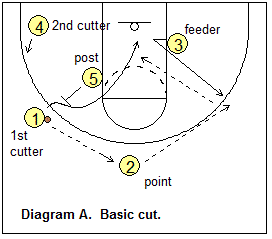
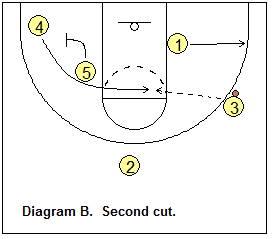
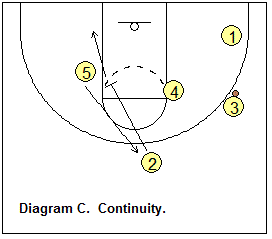
After setting the screen for O1, O5 then screens for O4, the second cutter (who has drifted outside even up with O5). O4 then cuts to the high post or ball-side elbow looking for the pass and shot (diagram B).
If nothing develops, O2 down-screens for O5 who then pops out to become the point and O2 drops down to become the next feeder (diagram C). You now have the same set, but on the opposite side, and with different players occupying the shuffle positions. O3 is now the first cutter, O4 is the post, and O1 is the second cutter.
Ball Reversal, Continuity
Now study diagrams D, E and F. The same series of cuts is now run from this side, only this time, for the purpose of illustration of the back-cut option, you see O3 cutting back-door around O4. The first cutter has the option of cutting either way around the screen. Again, each player may have a scoring option.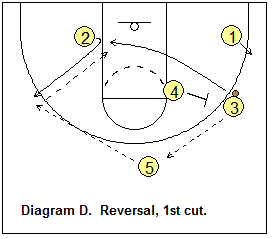
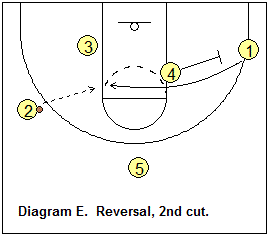
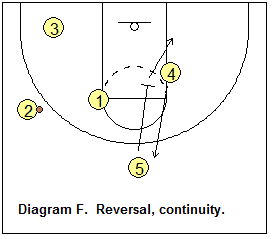
In diagram F, O2 is now the first cutter, O3 - the second cutter, O4 - the point, O1 - the post, and O5 - the feeder.
The "Split"
If the defense denies the pass back out to the point (diagram H), run the "split" with the pass going into the high post O1. This pass triggers the point O4 to set a down-screen for the feeder O5 and they exchange positions (diagram I). Meanwhile the first cutter O2 down-screens for the second cutter O3, who comes around the post looking for the shot. If the shot is not there, O3 can start the basic shuffle cut motion again (diagram J).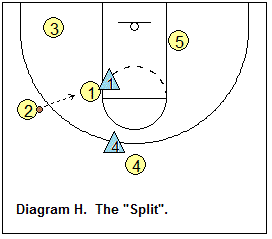
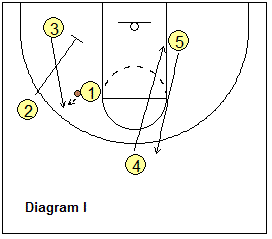

Usually the pass to the post (diagram H) is available, as the defense usually plays behind the post at the elbow. However, if the post is fronted (diagram K), then the feeder O3 moves up to the elbow (for spacing), and the post O5 pins the X5 defender and cuts inside for the "over-the-top" lob pass.
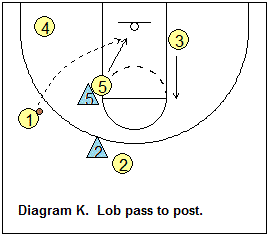
Strongside, Corner Option
Again, the pass to the point is being denied (diagram L). Our second cutter O4 recognizes this and cuts to the corner for the pass from O1 as another option. After this pass, the post O5 again sets the screen for the first cutter O1, who either cuts over or under the screen, for the pass from O4 (diagram M).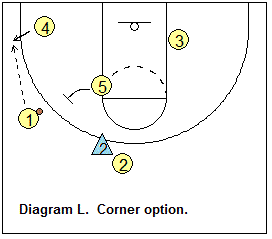
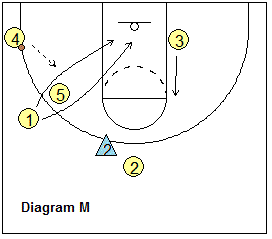
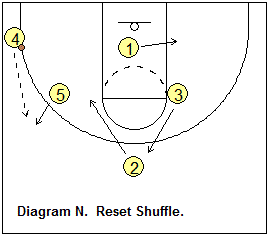
O4 could also take the shot from the corner. If neither is available, our post O5 steps outside to become the new first cutter and receives the pass (diagram N). The offense resets with O2 dropping into the post, O3 moving out to the point and O1 is now the feeder.
Diagonal Option
Once again, the pass to the point is being denied (diagram O). This time, our point O2 takes the X2 defender high outside. The feeder O3 recognizes this and cuts to the top of the key underneath the X2 defender and receives the pass from O1. The point O2 now cuts hard around O3 who screens the X2 defender and hands the ball off to O2 going to the hoop for the lay-up (diagram P).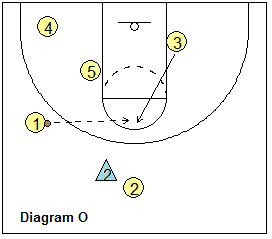
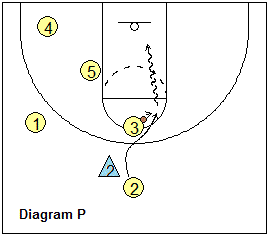
Feeder Back-cut Option
The defense is playing aggressive "on-the-line" man-to-man defense and the feeder O3 is being denied the pass from the point (diagram Q). The feeder O3 then plants the outside foot and makes a hard back-cut to the hoop, looking for the pass from the point O2 (diagram R).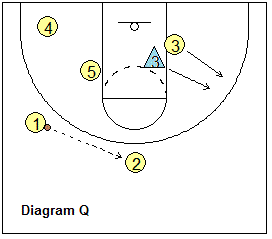
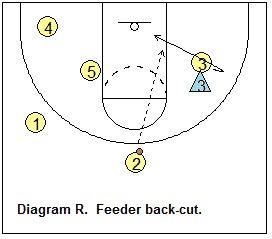
Point Pass Fake Option
You can call out this option as a play. The defense is playing man-to-man defense and the X4 defender has dropped down into the lane in helpside (diagram S). The offense starts the basic cut, but instead of the point O2 passing to the feeder O3, he/she makes a hard pass fake instead, shifting the defense to that side.The second cutter O4 cuts out to the wing for the pass from O2 and the shot (diagram T). The post O5 can drop down just above the block and post up, and you now have a two-man game with O4 and O5 (diagram U).
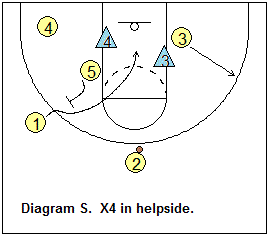
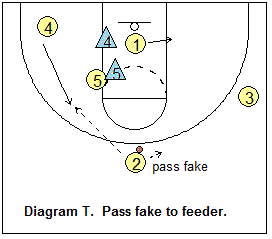
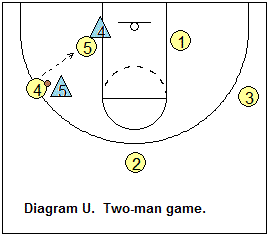
Dribble entry
See diagram V. If the pass is being denied, another option is to use the dribble entry where the first cutter O1 dribbles out to the point and exchanges positions with the point O2 (who now becomes the first cutter). The pass is then made to the feeder O3, and O2 executes the first cut.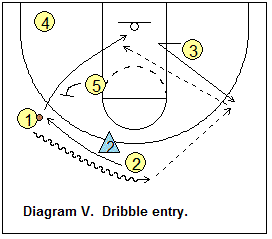
The dribble entry and exchange can also be made for the corner option described above wherein the first cutter would dribble to the corner and would exchange positions with the second cutter. Similarly, the point could dribble over to the feeder's usual position on the wing and the feeder would move out to the point.
Screens and Exchanges
In addition to the dribble entry and exchanges just described, exchanges can be made away from the ball. Diagram W shows the post O5 setting a screen for the feeder O3 and exchanging positions. In diagram X, the point down-screens for the post O3 and they exchange positions.Finally, in diagram Y, the second cutter screens for the feeder and exchanges positions. These are just some of the ways of getting the passing lanes opened up against a pressure defense.
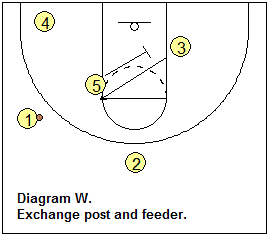
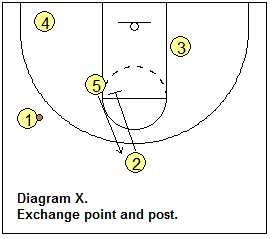
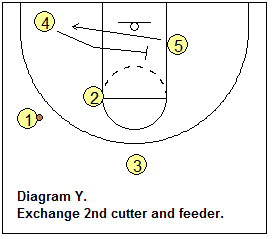
After an Offensive Rebound
After the missed shot, and the offensive rebound is secured, the rebounder should go right back up for the put-back shot if available. If not, or if you are trying to run the clock down, bring the ball outside and set up the offense.The shuffle creates movement and scoring opportunities for all five players and would be most effective against man-to-man defenses, but also could be useful against some zones, especially match-up zones. This offense favors a ball-control, intelligent team who has the patience to wait for a good scoring opportunity to develop.
The shuffle may take some time to teach as each player must learn all five positions and the various options. This could be an excellent offense for the smaller team that lacks a strong post player. With all five players moving and changing positions, mis-matches will occur where at times the defense's tall post players will find themselves defending their man out on the perimeter while their guards may get caught down near the basket.
Also, player substitution is easy since you can substitute your best player on the bench rather than a guard for a guard or a post for a post, since all positions are interchangeable. Additionally, opponents may have difficulty scouting this offense since a given player's role is constantly changing.
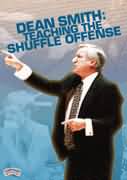
Dean Smith: Teaching the Shuffle Offense (DVD)
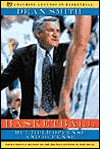
Basketball: Multiple Offense and Defense by Dean Smith. (format - Book)
An excellent book with sections on the free-lance passing offense, 1-4 offense, "T-game", basic cut-movement game, 4-corners offense, fast break offense, press-breakers, special situations and the shuffle offense. Defenses include pressure man defense, the run and jump defense, the "40"and the "50" defenses.